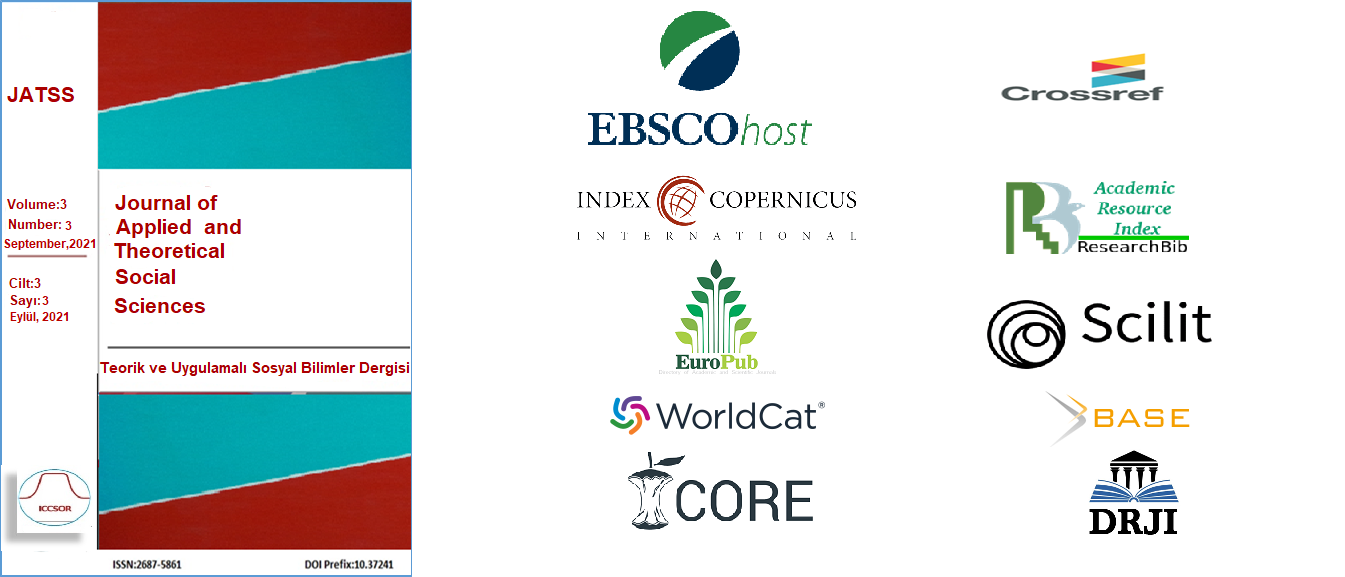Menşe Ülke, Daha Fazla Ödeme İsteği ve Satın Alma Niyeti Arasındaki İlişki: Türk Tüketicileri ile Hazır Giyim Ürünleri Üzerine Bir Araştırma
Özet
Büyük bir hızla değişen dünyamızda tüketiciler gün geçtikçe ürünler hakkında bir taraftan daha fazla bilgiye maruz kalırken bir diğer taraftan bu bilgiler ışığında kendileri için en doğru tercihlerde bulunmaya çalışmaktadır. Bu durum ise pazarlama alanında uygulama veya araştırma süreçlerinde yer alan pazarlamacılara farklı ürün bilgilerinin tüketim davranışları üzerindeki etkisini incelemelerinde geniş bir kapsam sağlamaktadır. Menşe ülke bilgisi de tüketicilerin ilgili ürünlere dair kalite algısı, satın alma tercihleri ve diğer hususlar üzerinde etkiye sahip olan bir nokta olarak görülmektedir. Tüketiciler belirli ülkelerin ürünlerini tercih etme eğiliminde olabilir veya o ülkenin ürününe yönelik olumlu algılara sahip olabilir. Belirli bir ürün için daha fazla ödeme isteğine sahip olunması noktasında tüketicilerde var olması muhtemel bu tarz pozitif algıların incelenmesi literatürde araştırılması gereken noktalardan birisiyken, bu konuyla ilgili bir boşluk söz konusudur. Çalışmanın amacı tüketicilerin menşe ülke bilgisinden hareketle sahip oldukları kalite algısının onların belirli bir ülke ürününe daha fazla ödeme isteği ve satın alma niyeti üzerindeki etkisini belirlemektir. Araştırma kapsamında online ortamda 720 adet tüketiciden online şekilde elde edilen veriler analize edilmiş ve sonrasında araştırma modeli test edilmiştir. Yapılan analizler sonucunda menşe ülke kalite algısı ile satın alma niyeti arasında anlamlı ve pozitif ilişki olduğu tespit edilmiştir. Ayrıca menşe ülke kalite algısının satın alma niyetine etkisinde daha fazla ödeme isteğinin aracılık rolünün bulunduğu tespit edilmiştir.
##plugins.generic.paperbuzz.metrics##
Referanslar
Abraham, A. and Patro, S. (2014). “‘Country-of-origin’ effect and consumer decision-making”. Management and Labour Studies, 39(3), 309-318. DOI: https://doi.org/10.1177/0258042X15572408
Ahmed, S. A. and d’Astous, A. (1995). “Comparison of country-of- origin effects on household and organizational buyers’ product perceptions”. European Journal of Marketing, 29(3), 35-51. DOI: https://doi.org/10.1108/03090569510145741
Ahmed, Z. U., Johnson, J. P., Yang, X., Kheng Fatt, C., Sack Teng, H. and Chee Boon, L. (2004). “Does country of origin matter for low-involvement products?”. International Marketing Review, 21(1), 102-120. DOI: https://doi.org/10.1108/02651330410522925
Aichner, T. (2014). “Country-of-origin marketing: A list of typical strategies with examples”. Journal of Brand Management, 21(1), 81-93. DOI: https://doi.org/10.1057/bm.2013.24
Ajzen, I. and Driver, B.L. (1992). “Application of the theory of planned behavior to leisure choice”. Journal of Leisure Research, 24, 207- 224. DOI: https://doi.org/10.1080/00222216.1992.11969889
Alexandris, K., Tsaousi, E. and James, J. (2007). “"Predicting sponsorship outcomes from attitudinal constructs: the case of a professional basketball event", Sport Marketing Quarterly, 16(3), 130-139.
Andéhn, M., Nordin, F. and Nilsson, M. E. (2016). “Facets of country image and brand equity: Revisiting the role of product categories in country-of-origin effect research”. Journal of Consumer Behaviour, 15(3), 225-238. DOI: https://doi.org/10.1002/cb.1550
Baron, R. M. and Kenny, D. A. (1986). Distinction in Social Psychological Research: Conceptual, Strategic, and Statistical Considerations. Journal of Personality and Social Psychology, 51(6), 1173- 1182. DOI: https://doi.org/10.1037/0022-3514.51.6.1173
Baughn, C. C. and Yaprak, A. (1993). “Mapping country-of-origin research: Recent developments and emerging avenues”. N. Papadopoulos ve L.A. Heslop (ed.) in: Product Country Images: Impact and Role in International Marketing. (s. 89-115). International Business Press: New York.
Bernard, Y. and Zarrouk-Karoui, S. (2014). “Reinforcing willingness to buy and to pay due to consumer affinity towards a foreign country”. International Management Review, 10(2), 57-67.
Bilkey, W. J. and Nes, E. (1982). “Country-of-origin effects on product evaluation”. Journal of International Business Studies, 13, 89-99. DOI: https://doi.org/10.1057/palgrave.jibs.8490539
Breidert, C., Hahsler, M. ve Reutterer, T. (2006). “A review of methods for measuring willingness-to-pay”. Innovative Marketing , 2(4), 8-32.
Carneiro, J. ve Faria, F. (2016). “Quest for purposefully designed conceptualization of the country-of-origin image construct”. Journal of Business Research, 69(10), 4411-4420. DOI: https://doi.org/10.1016/j.jbusres.2015.12.075
Chao, P. (1993). “Partitioning country of origin effects: Consumer evaluations of a hybrid product”. Journal of International Business Studies, 24(2), 291-306. DOI: https://doi.org/10.1057/palgrave.jibs.8490851
Chao, P. (2001). “The moderating effects of country of assembly, country of parts, and country of design on hybrid product evaluations”, Journal of Advertising, 30(4), 67-81. DOI: https://doi.org/10.1080/00913367.2001.10673652
Chattalas, M., Kramer, T. and Takada, H. (2008). “The impact of national stereotypes on the country-of-origin effect: A conceptual framework”. International Marketing Review, 25(1), 54-74. DOI: https://doi.org/10.1108/02651330810851881
Chowdhury, H. K. (2010). “The cognitive foundations of partitioned country-of-origin: A causal path analysis”. International Journal of Marketing Studies, 2(2), 258-266. DOI: https://doi.org/10.5539/ijms.v2n2p258
Chowdhury, H. K. and Ahmed, J. U. (2009). “An examination of the effects of partitioned country of origin on consumer product quality perceptions”. International Journal of Consumer Studies, 33, 496-502. DOI: https://doi.org/10.1111/j.1470-6431.2009.00783.x
Diamantopoulos, A., Schlegelmilch, B. and Palihawadana, D. (2011). “The relationship between country-of-origin image and brand image as drivers of purchase intentions: A test of alternative perspectives”. International Marketing Review, 28(5), 508-524. DOI: https://doi.org/10.1108/02651331111167624
Dichter, E. (1962). “The world customer”. Harvard Business Review, 40 (4),113-122. DOI: https://doi.org/10.1002/tie.5060040415
Dinnie, K. (2004). “Country-of-origin 1965-2004: A literature review”. Journal of Customer Behaviour, 3(2), 165-213. DOI: https://doi.org/10.1362/1475392041829537
Dodds, W. B., Monroe, K. B. and Grewal, D. (1991). “Effects of price, brand, and store information on buyer’s product evaluations”. Journal of Marketing Research, 28, 307-319. DOI: https://doi.org/10.1177/002224379102800305
Drozdenko, R. and Jensen, M. (2009). “Translating country-of-origin effects into prices”. Journal of Product & Brand Management, 18(5), 371-378. DOI: https://doi.org/10.1108/10610420910981855
Elliot, G. R. and Cameron, R. C. (1994). “Consumer perception of product quality and the country-of-origin effect”. Journal of Intemational Marketing, 2(2), 49-62. DOI: https://doi.org/10.1177/1069031X9400200204
Ha-Brookshire, J. and Yoon, S.-H. (2012). “Country of origin factors influencing US consumers’ perceived price for multinational products”. Journal of Consumer Marketing, 29(6), 445-454. DOI: https://doi.org/10.1108/07363761211259250
Hair, J. F., Black, W.C., Babin, B. J. and Anderson, R. E. (Ed.) (2013). Multivariate Data Analysis. (Seventh Edition), Pearson New International Edition, Pearson: Essex.
Hamzaoui, L. ve Merunka, D. (2006). “The impact of country of design and country of manufacture on consumer perceptions of bi-national products’ quality: An empirical model based on the concept of fit”. Journal of Consumer Marketing, 23(3), 145-155. DOI: https://doi.org/10.1108/07363760610663303
Han, C. M. and Tersptra, V. (1988). “Country-of-origin effects for uni-national and bi-national products”. Journal of International Business Studies, 19, 235-256. DOI: https://doi.org/10.1057/palgrave.jibs.8490379
Homburg, C., Koschate, N. and Hoyer, W. D. (2005). “Do satisfied customers really pay more? A study of the relationship between customer satisfaction and willingness to pay”. Journal of Marketing, 69(2), 84-96. DOI: https://doi.org/10.1509/jmkg.69.2.84.60760
Hong, S.-T. and Wyer, R. S. (1989). “Effects of country-of-origin and product-attribute information on product evaluation: An information processing perspective”. Journal of Consumer Research, 16(2), 175-187. DOI: https://doi.org/10.1086/209206
Hooley, G. J., Shipley, D. and Krieger, N. (1988). “A method for modelling consumer perceptions of country of origin”. International Marketing Review, 5(3), 67-76. DOI: https://doi.org/10.1108/eb008359
Huppertz, J. W., Arenson, S. J. and Evans, R. H. (1978). “An application of equity theory to buyer-seller exchange situations”. Journal of Marketing Research, 15 (2), 250-260. DOI: https://doi.org/10.1177/002224377801500208
Insch, G. S. and McBride J. B. (1999). “Decomposing the country-of-origin construct”. Journal of International Consumer Marketing, 10(4), 69-91. DOI: https://doi.org/10.1300/J046v10n04_05
Johansson, J. K., Douglas, S. and Nonaka, I. (1985). “Assessing the impact of country of origin on product evaluations: A new methodological perspective”. Journal of Marketing Research, 22(4), 388-396. DOI: https://doi.org/10.1177/002224378502200404
Josiassen, A., Lukas, B. A., Whitwell, G. J. and Assaf, A. G. (2013). “The halo model of origin images: Conceptualisation and initial empirical test”. Journal of Consumer Behaviour, 12(4), 253-266. DOI: https://doi.org/10.1002/cb.1405
Kalicharan, H. D. (2014). “The effect and influence of country-of-origin on consumers’ perception of product quality and purchasing intentions”. International Business and Economics Research Journal, 13(5), 897-902. DOI: https://doi.org/10.19030/iber.v13i5.8760
Keller, K. L. (2013). Strategic Brand Management: Building, Measuring, and Managing Brand Equity (4 Ed., Global Edition). Pearson: U.K.
Kim, N., Chun, E. and Ko, E. (2017). “Country of origin effects on brand image, brand evaluation, and purchase intention: A closer look at Seoul, New York, and Paris fashion collection”. International Marketing Review, 34(2), 254-271. DOI: https://doi.org/10.1108/IMR-03-2015-0071
Kim, R. B. and Chao, Y. (2018). “The effect of country of origin on consumer- based brand equity (CBBE) of Colombian consumers: An empirical investigation of Samsung vs. Huawei brands”. Journal of International Studies, 11(3), 70-81. DOI: https://doi.org/10.14254/2071-8330.2018/11-3/6
Koschate-Fischer, N., Diamantopoulos, A. and Oldenkotte, K. (2012). “Are consumers really willing to pay more for a favorable country image? A study of country-of-origin effects on willingness to pay”. Journal of International Marketing, 20(1), 19-41. DOI: https://doi.org/10.1509/jim.10.0140
Kotler, P. and Keller, K. L. (Ed.). (2015). Marketing Management (15 Ed., Global Edition). Pearson: U.S.A.
Kucher, A., H., M., Kucher, L., and Raszka, B. (2019). “Factors Forming the Consumers' Willingness to Pay a Price Premium for Ecological Goods in Ukraine”. International Journal of Environmental Research and Public Health, 16(5), 859. DOI: https://doi.org/10.3390/ijerph16050859
Laroche, M., Papadopoulos, N. Heslop, L. and Mourali, M. (2005). “The influence of country image structure on consumer evaluations of foreign products”. International Marketing Review, 22(1), 96-115. DOI: https://doi.org/10.1108/02651330510581190
Li, Z. G. and Dant R. P. (1998). “Dimensions of product quality and country of origin effects research”. Journal Of International Consumer Marketing. 10(1/2), 93-114. DOI: https://doi.org/10.1300/J046v10n01_06
Lin, L.-Y. and Chen, C.-S. (2006). “The influence of the country-of-origin image, product knowledge and product involvement on consumer purchase decisions: An empirical study of insurance and catering services in Taiwan”. Journal of Consumer Marketing, 23(5), 248-265. DOI: https://doi.org/10.1108/07363760610681655
Martin, I. M. and Eroğlu, S. (1993). “Measuring a multi-dimensional construct: Country image”. Journal of Business Research, 28, 191-210. DOI: https://doi.org/10.1016/0148-2963(93)90047-S
Matarazzo, M. (2012). “Country of origin effect: research evolution, basic constructs and firm implications”. G. Bertoli and R. Resciniti (ed.). içinde: International Marketing and the Country of Origin Effect: The Global Impact of ‘Made in Italy’. (s. 23- 42). Edward Elgar Publishing Limited: Cheltenham: UK. DOI: https://doi.org/10.4337/9781781955611.00008
Monroe, K. B. (2003). Pricing: Making Profitable Decisions (3. Ed.). McGraw-Hill/Irwin, Boston.
Mutlu, H. M. and Yılmaz, C. (2017). Antecedents of willingness to pay a price premium. 20th International Scientific Conference “Economic and Social Development”, 27-28 Nisan 2017, Prag. 307-313.
Nagashima, A. (1970). “A comparison of Japanese and U. S. attitudes toward foreign products”. Journal of Marketing, 34(1), 68-74. DOI: https://doi.org/10.1177/002224297003400115
Netemeyer, R. G., Krishnan, B., Pullig, C., Wang, G., Yağcı, M., Dean, D., Ricks, J. ve Wirth, F. (2004). “Developing and validating measures of facets of customer-based brand equity”. Journal of Business Research,57, 209-224. DOI: https://doi.org/10.1016/S0148-2963(01)00303-4
Oliver, R. L. and DeSarbo, W. S. (1988). “Response determinants in satisfaction judgments”. The Journal of Consumer Research, 14(4), 495-507. DOI: https://doi.org/10.1086/209131
Papadopoulos, N. and Heslop, L. A. (Ed.). (1993). Product country images: impact and role in international marketing. International Business Press: New York.
Pappu, R., Quester, P. G. and Cooksey, R. W. (2006). “Consumer‐based brand equity and country‐ of‐origin relationships: Some empirical evidence”. European Journal of Marketing, 40 (5/6), 696-717. DOI: https://doi.org/10.1108/03090560610657903
Parameswaran, R. and Yaprak, A. (1987). “A Cross-National Comparison of Consumer Research Measures”. Journal of International Business Studies, 18, 35-49. DOI: https://doi.org/10.1057/palgrave.jibs.8490398
Pearce, D.W. (1983). Cost-Benefit Analysis (2. Ed). The Macmillan Press Ltd.: London. DOI: https://doi.org/10.1007/978-1-349-17196-5
Peterson, R. A. and Jolibert, A. J. P. (1995). “A meta-analysis of country-of-origin effects”. Journal of International Business Studies, 26(4), 883-900. DOI: https://doi.org/10.1057/palgrave.jibs.8490824
Phau, I. and Chao, P. (2008). “Country-of-origin: State of the art review for international marketing strategy and practice”. International Marketing Review, 25(4), 1-4. DOI: https://doi.org/10.1108/imr.2008.03625daa.001
Piron, F. (2000). “Consumers' perceptions of the country-of-origin effect on purchasing intentions of (in)conspicuous products”. Journal of Consumer Marketing, 17(4),308-321. DOI: https://doi.org/10.1108/07363760010335330
Roth, K. P. and Diamantopoulos, A. (2009). “Advancing the country image construct”. Journal of Business Research, 62, 726-740. DOI: https://doi.org/10.1016/j.jbusres.2008.05.014
Roth, M. S. and Romeo, J. B. (1992). “Matching product category and country image perceptions: A framework for managing country-of-origin effects”. Journal of International Business Studies, 23(3), 477- 497. DOI: https://doi.org/10.1057/palgrave.jibs.8490276
Samiee, S. (1994). “Customer evaluation of products in a global market”. Journal of International Business Studies, 25(3), 579- 604. DOI: https://doi.org/10.1057/palgrave.jibs.8490213
Saridakis, C. and George, B. ( 2015). “Modeling Country-Of-Origin Effects in the Car Market: Implications for Pricing”. K. Kubacki (ed.). içinde: Ideas in Marketing: Finding the New and Polishing the Old. (s. 534-541). Springer: Cham. DOI: https://doi.org/10.1007/978-3-319-10951-0_193
Schooler, R. D. (1965). “Product bias in the central american common market”. Journal of Marketing Research, 2(4), 394-397. DOI: https://doi.org/10.1177/002224376500200407
Şentürk, T. (2018). “Ülke imajı araştırmalarında ölçek seçimi ve kullanımı”. Selçuk Üniversitesi Sosyal Bilimler Meslek Yüksekokulu Dergisi, 21(1), 78-91. DOI: https://doi.org/10.29249/selcuksbmyd.407367
Silva, C. A. P. F., Monico, L. S. M., Porfirio, J. A. F. and Almeida, M. R. A. (2014). “From the country of origin effect to the origin of the brand-an approach from the viewpoint of the literature review”. SGEM2014 Conference on Political Sciences, Law, Finance, Economics and Tourism. STEF92 Technology, 295-302. DOI: https://doi.org/10.5593/sgemsocial2014/B24/S7.038
Steenkamp, J.B. (1990). “Conceptual model of the quality perception process”. Journal of Business Research, 21, 309-333. DOI: https://doi.org/10.1016/0148-2963(90)90019-A
Steenkamp, J.-B., Batra, R. and Alden, D. L. (2003). “How perceived brand globalness creates brand value”. Journal of International Business Studies, 34, 53-65. DOI: https://doi.org/10.1057/palgrave.jibs.8400002
Tanrıkulu, C. (2015). “Eşitlik Teorisi”. M. İ. Yağcı and S. Çabuk (ed.). içinde: Pazarlama Teorileri. (s. 131-146). MediaCat : İstanbul.
Thakor, M. V. and Kohli, C. S. (1996). “Brand origin: Conceptualization and review”. Journal of Consumer Marketing, 13(3), 27-42. DOI: https://doi.org/10.1108/07363769610147929
Thakor; M.V. and Katsanis, L. P. (1997). “A model of brand and country effects on quality dimensions”. Journal of International Consumer Marketing, 9(3), 79-100. DOI: https://doi.org/10.1300/J046v09n03_06
Tse, D. K. and Gorn, G. J. (1993). “An experiment on the salience of country-of-origin in the era of global brands”. Journal of International Marketing, 1(1), 57-76. DOI: https://doi.org/10.1177/1069031X9300100105
Tse, D. K. and Lee, W.-N. (1993). “Removing negative country images: Effects of decomposition, branding, and product experience”. Journal of International Marketing, 1(4), 25-48. DOI: https://doi.org/10.1177/1069031X9300100403
Verlegh, P. W.J. and Steenkamp, J.B. (1999). “A review and meta-analysis of country-of-origin research”. Journal of Economic Psychology, 20, 521-546. DOI: https://doi.org/10.1016/S0167-4870(99)00023-9
Wall, M. and Heslop, L. A. (1986). “Consumer attitudes toward Canadian-made versus imported products”. Journal of the Academy of Marketing Science, 14(2), 27-36. DOI: https://doi.org/10.1007/BF02722154
Walster, E., Berscheid, E. and Walster, G. W. (1973). “New directions in equity search”. Journal of Personality and Social Psychology, 25(2), 151-176. DOI: https://doi.org/10.1037/h0033967
Yılmaz, H. (2020). Spor pazarlamasında tüketicilerin taraftar kimliklerinin sponsor markalara yönelik tercihlerine etkisi: Farklı ilgilenim düzeylerindeki ürün gruplarında deneysel bir araştırma. Yayınlanmamış Doktora Tezi. İstanbul Üniversitesi: İstanbul.
Zeithaml, V. A. (1988). “Consumer perceptions of price, quality and value: A means-end model and synthesis of evidence”. Journal of Marketing, 52, 2-22. DOI: https://doi.org/10.1177/002224298805200302
Zhao, X., Lynch, J.G. and Chen, Q. (2010). “Reconsidering Baron and Kenny: Myths and truths about mediation analysis”. Journal of Consumer Research Inc., 37 (2), 197-206. DOI: https://doi.org/10.1086/651257






















